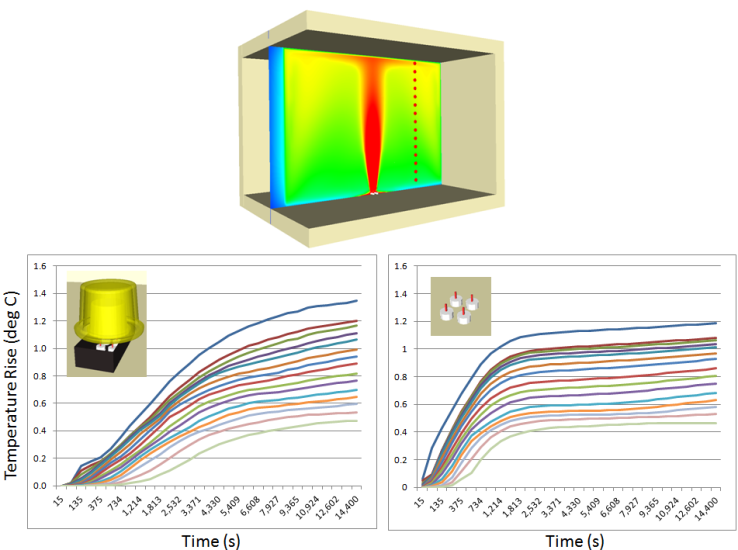Heat Your Home Office for 8p (10cents) a Day. Part 3 – It Takes Time
Dylan in his original YouTube video made the point that the tea lights only burn for about 4 hours and that he replaces them after the morning burn for an afternoon warm up session. At 1p per candle, 1p/~35W, we shouldn’t lose sight of how cost effective this heating method is. There is some doubt as to the actual power dissipation for each candle but this approach is scalable, if a 4 candle arrangement isn’t enough, then just consider using 2 or 3 such candle+flower pot arrangements! Let’s continue to compare and contrast the effect of using the flower pots, or not, in the context of how warm the room air gets after 4 hours.
It was with a certain sense of arrogance that I had assumed that the flower pot configuration, as it captures more of the power dissipated by the 4 candles and provides that back to the air, would result in the room air heating up more quickly. One advantage of simulation is that it helps you learn from your mistakes (make your mistakes early and often!). Starting with the room at a very chilly 0 degC, using Simcenter Flotherm I simulated the increase in temperature in the room over a 4 hour period. Specifically at a series of points, half way between the candles and the wall, from ceiling to floor.
Without the flower pots the air temperature in the room establishes itself relatively quickly (graph on the right). Within about 20 minutes the temperature stratification settles down, hotter at the ceiling, getting colder as it reaches the floor as hot air rises (…and HeatSinks, an electronics cooling ‘joke’ and title of the excellent book by Tony Kordyban, sorry getting a bit off topic). From then the air temperature rises slowly as the wall temperature rises slowly due to the radiative heating direct from the candle flames.
With the flower pots on top of the candles, the room air heats up more slowly. Sure, after a while the room air gets hotter as more power is provided directly to the air, but it takes time. The reason is due to the thermal capacitance of the pots. They are dense. It takes quite a few Joules of energy to soak the ceramic material to the extent where it then passes those Joules back to the air. [Analogies of soaking, sponges, water etc. are often useful when creating mental constructs to perceive heat transfer processes]. At the end of the 4 hours the air is hotter in the top of the room compared to the naked candles, about the same near the floor.
However, in both instances, the air temperature achieves only about 75% of the maximum temperature rise were the candles to burn indefinitely. This thermal soaking period of the flower pots, that delays the increase in air temperature, could be overcome by say pre-heating the pots in an oven, maybe at the same time as you bake your morning loaf of bread?
In terms of how warm you feel as a human occupant, air temperature is only one factor. There are other factors that need to be taken into account when judging thermal comfort. I’ve touched on these before and I believe that when taking them into consideration in this study, the thermal comfort benefits of the flower pot heater will become more pronounced (O dear, more arrogance).
All the Blogs in this series:



